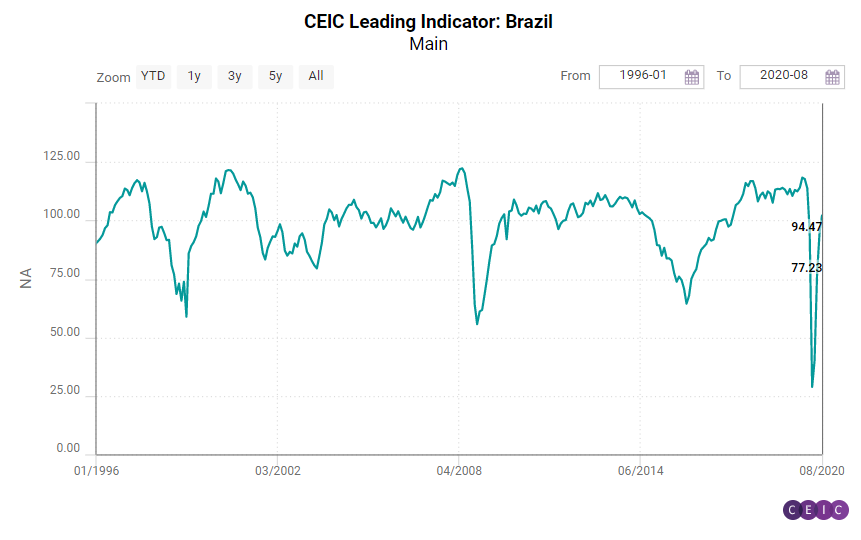-jpg.jpeg)
The CEIC Leading Indicator is a proprietary dataset designed by CEIC Insights to precede the development of major macroeconomic indicators and predict the turning points of the economic cycle for key markets. It is a composite leading indicator which is calculated by aggregating and weighting selected leading indicators covering various important sectors of the economy, such as financial markets, the monetary sector, labour market, trade and industry. It is developed through a proprietary CEIC methodology and employs data from the CEIC database. The CEIC Leading Indicator currently covers eight regions – Brazil, China, India, Indonesia, Russia, the Euro Area, Japan and the United States.
In August, for the first time in six months, the CEIC Leading Indicator for Brazil exceeded the base value of 100 to reach 102.1, the fourth increase in a row, meaning that the country may see an economic upturn in the first quarter of 2021. The positive performance in August was supported by some key variables. The manufacturing confidence indicator was -1.3, the highest level since February 2020, compared to -10.2 in July. Motor vehicle sales continued to accelerate in August, reaching 193,650 units in the month, compared to 184,818 in July. The construction companies foresee a rebound of the sector’s activity, as the expectation to purchase inputs improved to 52.8 in August 2020, above the neutral value of 50, and is almost at the same level as in August 2019 (52.6). International crude oil prices continued to rebound, reaching USD 45.2 per barrel in August, compared to USD 43.4 per barrel in July. The equity market index, however, inched down to 99,369 in the end of August, from 102,912 in the end of July, amid uncertainties related to the surge in government expenditures and the sustainability of public debt.

Brazil’s prospects for 2020 are still for a severe recession, as the smoothed CEIC Leading Indicator remained below the neutral point of 100 for most of the first half of the year, with a significant impact on the annual result. Nevertheless, from January 2021, the GDP is expected to start to rebound. The indicator interrupted its long-term negative trend in June, as the smoothed version had a slight uptick to 80, after registering a record low of 78.2 in May. The smoothed CEIC Leading Indicator reached 87.3 in August, the highest figure since February 2020, but still lower than 100. It means that despite the growth outlook in Q1 2021, the economy may continue operating below the pre-crisis level until the end of 2020.

Keep informed each month on the predicted turning points of the economic cycle for key markets with our free, proprietary CEIC Leading Indicator. Learn more and register here
.png?width=160&name=ceic-logo-Vector%20logo%20no%20tagline%20(002).png)
